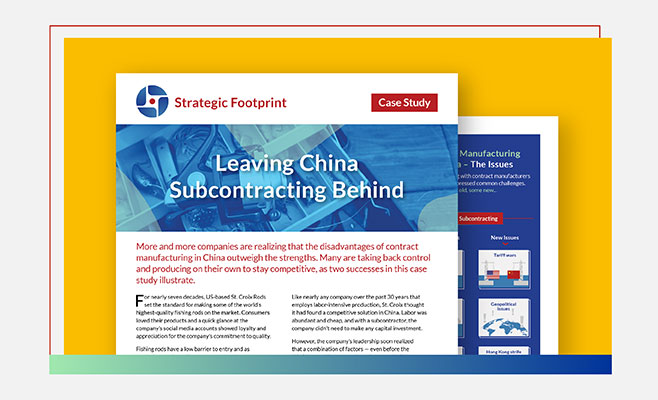US tariffs, political issues and supply chain lag are key elements driving US manufacturers to build product on their own, closer to home.
By Doug Donahue
In the past few years, a “China plus one” strategy has grown in popularity for companies looking to diversify their production footprint and avoid putting all their eggs in one basket. At the same time, a related trend of companies looking to end their reliance on subcontract manufacturing in China in favor of building product on their own closer to home has also materialized. And it has the potential to alter North American manufacturing significantly.
For companies relying exclusively or largely on subcontract manufacturing in China, the approach might be labeled a “China minus two” strategy, with the dual goals of 1) exiting China altogether and 2) building product on their own, rather than working through a subcontractor. More and more companies that produce for the North American market have either already made the shift or are exploring the required steps. Why? Because subcontract manufacturing in China has become just too risky.
Many consider the tariffs imposed by the US on China-originating imports as the key factor causing companies to re-examine their dependence on subcontract manufacturing in China. But in reality, it was just the most recent in a long list of issues, including:
Any one of these factors could be enough to threaten your entire business, whether a 20% tariff slapped onto your product originating in China or a botched order due to carelessness on the part of your supplier. Subcontract manufacturing in China is currently less appealing than ever before. And the upside of lower-cost production in China isn’t enough to justify significant risk to your business.
If you want to eliminate the headaches and hassles associated with subcontracting in China, where do you look for alternatives?
For many companies, shifting to a manufacturing your own product in North America is the sometimes-surprising answer. While there are initial investment costs and production costs can be higher (depending on location), you gain peace of mind for three important reasons.
The first is obviously proximity. Production in the USMCA region puts you closer to customers and enables you to modify production lines much more quickly due to seasonal changes, shifts in consumer taste or to launch a new product. Without the monthlong wait for the boat from China, that agility will give you a big leg up in customer responsiveness. Plus, you benefit from zero-tariff policy.
Second is the protection of intellectual property. China offers few safeguards to your designs and product blueprints. It’s even more problematic when you work with a subcontractor, as you have almost zero insight into who else your supplier is working with or selling your ideas to. By moving to your own production in North America, you gain a lot more security and respect for the rule of law.
Finally, by building product yourself rather than outsourcing to a subcontractor, you have full control of quality, which may be the greatest benefit altogether of the transition. In moving away from a China subcontractor, you oversee quality assurance, versus being completely dependent on the whim of a suppler thousands of miles away, with nothing more than a contract and the hope that they live up to their side of it.
When you build your own product, your workforce is responsible for exacting quality safeguards, versus the dreaded (but all too common) scenario when you work with a subcontractor: your customer performs de facto QA, conveying feedback in the form of an angry phone call when a shipment full of broken product arrives.

Strategic Footprint is a new firm helping companies explore shifting from subcontract manufacturing in China to building their own product.
Shifting to a strategy of building product versus buying it seems daunting if you’ve never produced on your own before. But with the right guidance you can shift away from subcontract manufacturing in China and manufacture your own product in North America.
To help companies make the transition, we formed Strategic Footprint, a firm that guides companies in evaluating all costs of manufacturing and delivery, so companies can build product on their own closer to home and take back full control of their brand.
Me and my partner Bob Penicka, a former COO of Callaway Golf, have decades of experience in guiding companies in setting up and running their own production in North America. Plus, we are hands-on practitioners who have actually shifted production lines and entire companies away from subcontracting in Asia, replacing it with nearshore production in the U.S. and Mexico.
Learn more at www.strategicfootprint.com, where you can watch our video or download our “Leaving China Subcontracting Behind” success stories. We are happy to offer a no-obligation consultation and help you begin the process.

Doug Donahue
Doug Donahue is principal of Strategic Footprint, a new firm that helps companies move from subcontract manufacturing in China, in favor of building product on their own, closer to home.
Scott Ellyson, CEO of East West Manufacturing, brings decades of global manufacturing and supply chain leadership to the conversation. In this episode, he shares practical insights on scaling operations, navigating complexity, and building resilient manufacturing networks in an increasingly connected world.